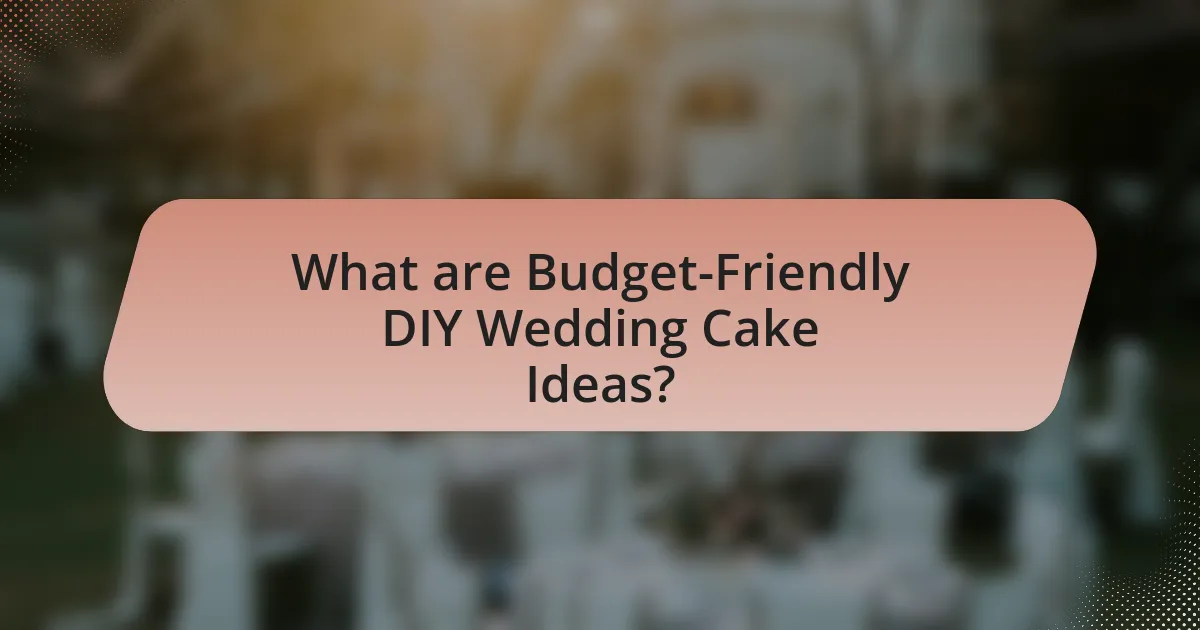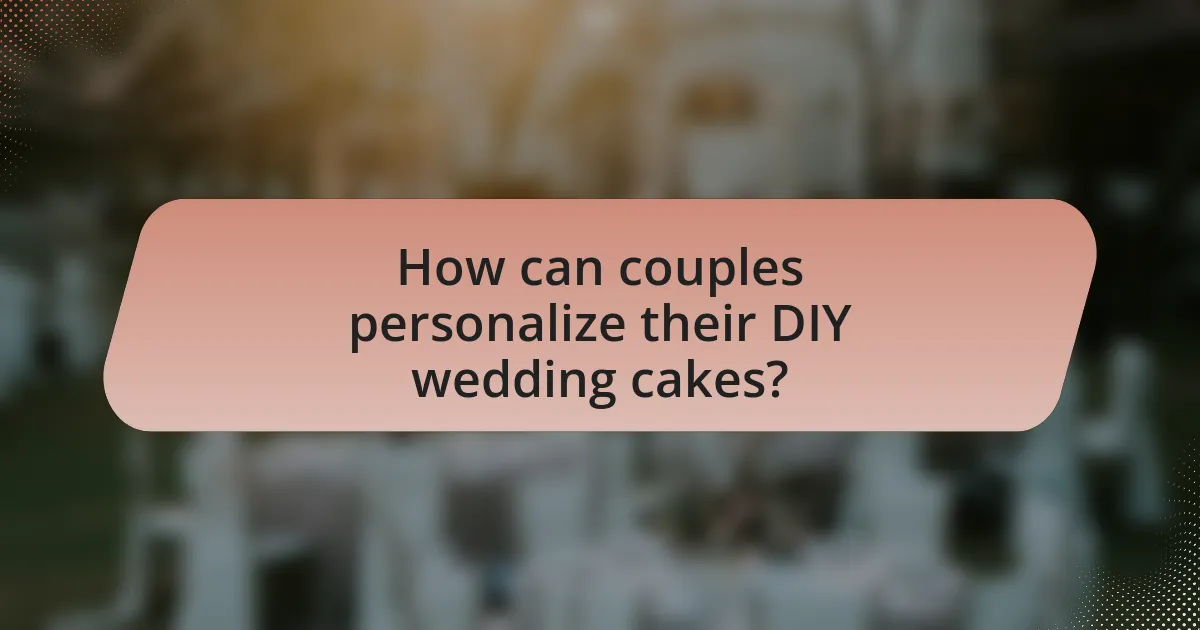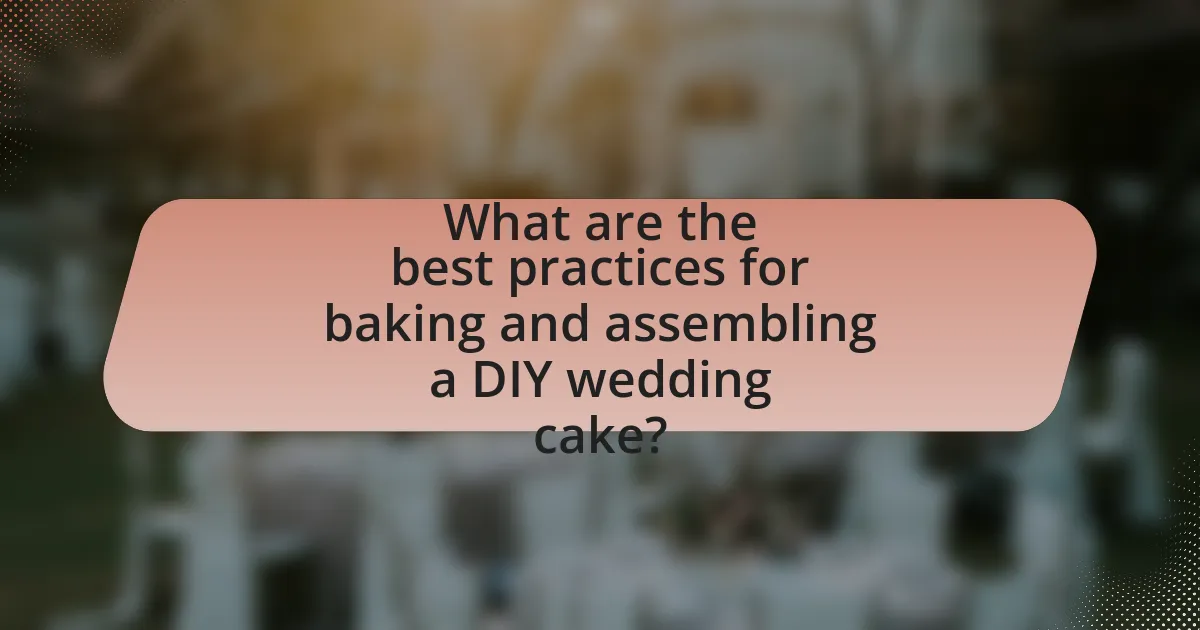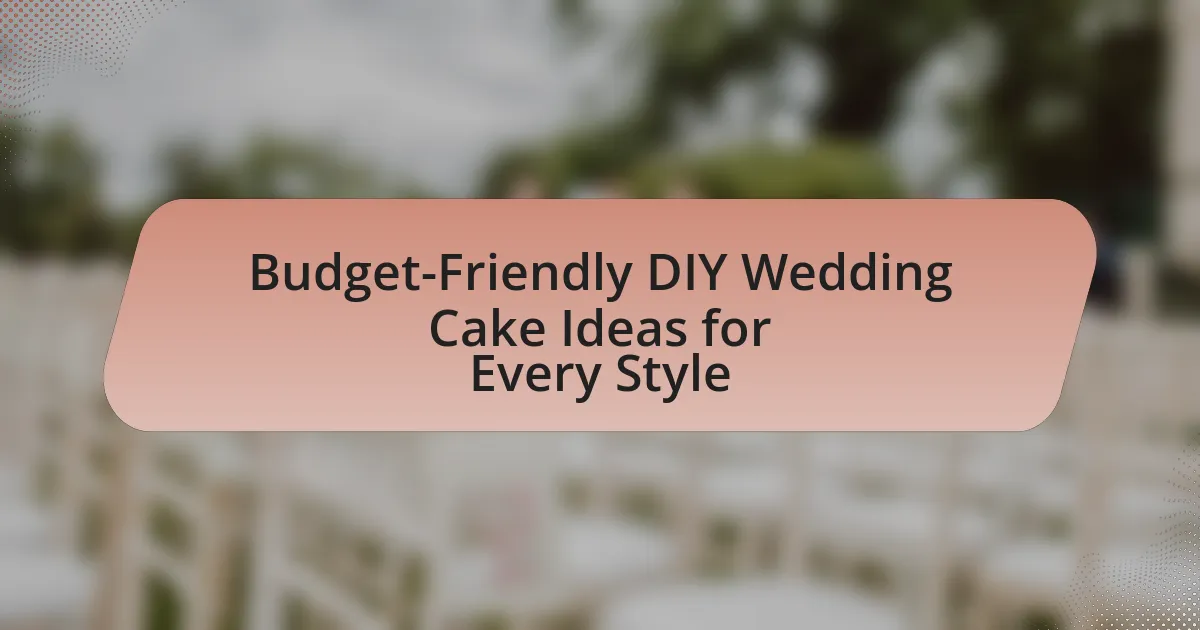The article focuses on budget-friendly DIY wedding cake ideas, providing practical strategies for couples looking to save money while personalizing their wedding cakes. It outlines various cost-effective approaches, such as using boxed cake mixes, simple tiered designs, and fresh decorations, which can significantly reduce expenses compared to traditional bakery options. Key sections include cost comparisons between DIY and professionally made cakes, effective budgeting tips, popular cake styles for different themes, and essential materials and techniques for successful cake creation. Additionally, the article offers troubleshooting advice and creative decoration ideas to enhance the overall presentation and flavor of DIY wedding cakes.

What are Budget-Friendly DIY Wedding Cake Ideas?
Budget-friendly DIY wedding cake ideas include using simple tiered cakes made from boxed cake mixes, decorating with fresh flowers or seasonal fruits, and opting for a single-layer cake with minimal frosting. These approaches reduce costs while allowing for personalization. For instance, a basic vanilla or chocolate cake can be transformed with homemade buttercream and a few strategically placed flowers, creating an elegant look without the expense of a professional baker. Additionally, utilizing cake stands and decorative elements from thrift stores can enhance the presentation at a lower cost.
How can DIY wedding cakes save money compared to traditional options?
DIY wedding cakes can save money compared to traditional options by significantly reducing labor and ingredient costs. Traditional wedding cakes often involve hiring professional bakers, which can range from hundreds to thousands of dollars, while DIY cakes allow couples to purchase ingredients directly, often at a fraction of the price. For example, a professionally made cake can cost around $3 to $8 per slice, whereas a DIY cake can be made for approximately $1 to $2 per slice, depending on the ingredients used. This cost-saving approach not only lowers the overall wedding budget but also allows for customization and personalization that may not be available with traditional bakeries.
What are the cost differences between DIY and professionally made wedding cakes?
DIY wedding cakes typically cost between $50 to $200, while professionally made wedding cakes can range from $300 to over $1,000, depending on factors like size, design complexity, and ingredients. The significant cost difference arises from the labor, expertise, and quality of materials involved in professionally made cakes, which often include intricate designs and premium ingredients. In contrast, DIY cakes may save on labor costs but require time, skill, and access to baking supplies, which can also add up.
How can couples budget effectively for a DIY wedding cake?
Couples can budget effectively for a DIY wedding cake by creating a detailed cost breakdown that includes ingredients, tools, and decorations. First, they should research and list all necessary ingredients, such as flour, sugar, eggs, and butter, and compare prices at local grocery stores or bulk suppliers to find the best deals. Additionally, couples should consider the cost of baking tools, such as pans and mixers, which can be borrowed or rented to minimize expenses.
Next, they should allocate a budget for decorations, including frosting, fondant, and edible embellishments, while exploring affordable DIY options like fresh flowers or fruits. By setting a clear budget and sticking to it, couples can avoid overspending and ensure they have a delicious cake that fits their financial plan. This approach is supported by the fact that DIY wedding cakes can save couples an average of 50% compared to purchasing from a bakery, making it a financially viable option.
What styles of wedding cakes can be created on a budget?
Budget-friendly wedding cakes can include simple tiered cakes, sheet cakes, and naked cakes. Simple tiered cakes often use minimal decoration and fewer tiers to reduce costs while still providing an elegant appearance. Sheet cakes are cost-effective as they require less labor and ingredients, allowing for larger servings at a lower price. Naked cakes, which feature minimal frosting and exposed layers, not only save on icing costs but also offer a rustic aesthetic that is popular in modern weddings. These styles effectively balance affordability with visual appeal, making them suitable for budget-conscious couples.
What are some popular DIY wedding cake styles for different themes?
Popular DIY wedding cake styles for different themes include rustic, elegant, and whimsical designs. Rustic cakes often feature natural elements like naked layers, fresh flowers, and textured buttercream, making them ideal for outdoor or barn weddings. Elegant cakes typically showcase smooth fondant finishes, intricate lace patterns, and metallic accents, suitable for formal or classic themes. Whimsical cakes embrace vibrant colors, playful shapes, and unique toppers, perfect for fun or unconventional celebrations. Each style allows couples to personalize their cakes while adhering to their wedding theme, ensuring a cohesive look throughout the event.
How can flavor choices impact the budget of a DIY wedding cake?
Flavor choices can significantly impact the budget of a DIY wedding cake by influencing ingredient costs and preparation complexity. For instance, premium flavors like chocolate ganache or exotic fruits typically require more expensive ingredients compared to basic vanilla or lemon. Additionally, intricate flavor combinations may necessitate specialized techniques or additional layers, increasing both time and resource expenditure. According to a survey by The Knot, couples can save up to 30% on their cake budget by opting for simpler flavors, as these often require less labor and fewer costly ingredients. Thus, selecting basic flavors can lead to substantial savings while still achieving a delicious cake.
What materials are needed for creating a DIY wedding cake?
To create a DIY wedding cake, the essential materials needed include cake flour, sugar, eggs, butter, baking powder, milk, and vanilla extract for the cake batter. Additionally, fondant or buttercream is required for frosting, along with food coloring for decoration. Baking tools such as mixing bowls, measuring cups, a whisk, and cake pans are also necessary. These ingredients and tools are fundamental for baking and decorating a wedding cake, ensuring it meets both aesthetic and taste expectations.
What basic baking supplies should every DIY wedding cake maker have?
Every DIY wedding cake maker should have essential baking supplies including flour, sugar, eggs, butter, baking powder, and vanilla extract. These ingredients form the foundation of most cake recipes, ensuring a successful bake. Additionally, tools such as mixing bowls, measuring cups, a whisk, a spatula, and cake pans are crucial for preparation and baking. A cooling rack is also necessary for proper cooling of the cakes before decorating. These supplies are standard in baking and are widely recognized as fundamental for creating cakes, as they provide the necessary components for structure and flavor.
How can couples source affordable decorations for their wedding cake?
Couples can source affordable decorations for their wedding cake by utilizing DIY methods, shopping at discount stores, and exploring online marketplaces. DIY decorations, such as handmade sugar flowers or edible glitter, can significantly reduce costs while allowing for personalization. Discount stores often carry budget-friendly items like cake toppers and decorative elements, while online marketplaces like Etsy provide access to unique, affordable options from independent sellers. According to a survey by The Knot, couples who incorporate DIY elements into their wedding save an average of 20% on overall costs, demonstrating the effectiveness of these strategies.

How can couples personalize their DIY wedding cakes?
Couples can personalize their DIY wedding cakes by incorporating unique flavors, designs, and decorations that reflect their individual tastes and relationship. For instance, they can choose cake flavors that hold special significance, such as the first dessert they shared or a family recipe. Additionally, couples can customize the cake’s appearance by selecting colors and themes that align with their wedding decor, using edible flowers, or adding personal touches like monograms or meaningful symbols. This approach not only enhances the cake’s aesthetic but also creates a memorable experience that resonates with their love story.
What are some creative decoration ideas for DIY wedding cakes?
Creative decoration ideas for DIY wedding cakes include using fresh flowers, edible glitter, and fruit arrangements. Fresh flowers can enhance the cake’s aesthetic by adding natural beauty and color, while edible glitter provides a touch of sparkle that can elevate the overall presentation. Fruit arrangements, such as berries or citrus slices, not only add visual appeal but also offer a fresh flavor contrast. These methods are cost-effective and allow for personalization, making them ideal for budget-friendly wedding cakes.
How can edible flowers enhance the look of a DIY wedding cake?
Edible flowers can significantly enhance the look of a DIY wedding cake by adding vibrant colors, unique textures, and a touch of elegance. These flowers, such as pansies, roses, and violets, provide a natural aesthetic that complements various cake designs, making them visually appealing. According to a study published in the Journal of Culinary Science & Technology, the use of edible flowers not only improves the cake’s appearance but also adds flavor and aroma, enriching the overall sensory experience. This combination of visual and sensory enhancement makes edible flowers an effective choice for elevating the presentation of a DIY wedding cake.
What are some unique frosting techniques that can be used?
Some unique frosting techniques that can be used include the watercolor technique, where different shades of frosting are blended to create a soft, painted effect, and the ruffle technique, which involves piping ruffles for a textured look. The watercolor technique allows for a visually appealing gradient effect, while the ruffle technique adds dimension and elegance to the cake. Both techniques can enhance the aesthetic of a wedding cake without requiring expensive materials or tools, making them budget-friendly options for DIY wedding cakes.
How can couples incorporate their wedding theme into their cake design?
Couples can incorporate their wedding theme into their cake design by selecting colors, decorations, and flavors that reflect the overall aesthetic and style of their wedding. For example, if the wedding theme is rustic, couples might choose a naked cake adorned with fresh flowers and greenery, while a vintage theme could inspire a cake with intricate lace patterns and pastel colors. Additionally, flavors can be aligned with the theme; a tropical wedding might feature coconut and pineapple flavors, enhancing the cohesive experience. This approach ensures that the cake not only serves as a dessert but also as a visual centerpiece that resonates with the wedding’s overall theme.
What are some examples of themed DIY wedding cakes?
Examples of themed DIY wedding cakes include rustic naked cakes adorned with fresh flowers, elegant fondant-covered cakes featuring intricate lace designs, and whimsical cakes shaped like favorite storybook characters. Rustic naked cakes emphasize simplicity and natural beauty, often using seasonal blooms for decoration, while fondant-covered cakes allow for detailed designs that can reflect the couple’s style or wedding theme. Whimsical cakes can incorporate playful elements, such as vibrant colors and unique shapes, making them memorable for themed weddings. These examples showcase the versatility and creativity possible in DIY wedding cake design, catering to various themes and personal preferences.
How can color schemes influence the design of a DIY wedding cake?
Color schemes significantly influence the design of a DIY wedding cake by dictating the overall aesthetic and emotional tone of the cake. A well-chosen color palette can enhance the visual appeal, align with the wedding theme, and evoke specific feelings; for instance, soft pastels may create a romantic atmosphere, while bold colors can convey vibrancy and excitement. Research indicates that colors can affect perceptions and emotions, with studies showing that certain colors are associated with specific feelings—blue often represents calmness, while red can signify passion. Therefore, selecting a cohesive color scheme not only enhances the cake’s design but also reinforces the wedding’s overall theme and mood.

What are the best practices for baking and assembling a DIY wedding cake?
The best practices for baking and assembling a DIY wedding cake include careful planning, precise measurements, and proper techniques. First, select a reliable recipe that suits your skill level and desired flavor; for example, a basic vanilla or chocolate cake is often a good starting point. Next, ensure accurate ingredient measurements using a kitchen scale, as this affects the cake’s texture and rise.
When baking, preheat the oven and use the correct pan sizes to achieve even baking; this is crucial for a stable structure. Allow the cakes to cool completely before assembling to prevent melting or collapsing. For assembly, use a sturdy cake board and level the cakes with a serrated knife for even stacking. Apply a crumb coat—a thin layer of frosting—to seal in crumbs, followed by a final layer of frosting for a polished finish.
Additionally, consider using dowels or straws for support in multi-tiered cakes, as this prevents sagging. These practices are supported by baking experts who emphasize the importance of precision and technique in achieving a successful cake.
How can couples ensure their DIY wedding cake is structurally sound?
Couples can ensure their DIY wedding cake is structurally sound by using proper support systems, such as dowels or cake boards, to stabilize each layer. Dowels should be inserted into the bottom layer to distribute the weight of the upper layers evenly, preventing collapse. Additionally, using a sturdy cake recipe that can hold its shape, such as a dense butter cake, contributes to structural integrity. According to cake decorating experts, a well-constructed cake should have a solid base and layers that are not overly tall, as this reduces the risk of tipping or breaking.
What are the key steps in stacking and supporting multiple tiers?
The key steps in stacking and supporting multiple tiers of a wedding cake include preparing a sturdy base, using dowels for support, and ensuring proper alignment. First, a strong base, such as a cake board, is essential to distribute the weight evenly. Second, inserting dowels into the lower tiers provides structural integrity, preventing the upper tiers from sinking. Typically, three to four dowels are used per tier, depending on the cake’s size. Finally, careful alignment of each tier is crucial to maintain stability and aesthetics, ensuring that the cake remains balanced and visually appealing. These steps are critical for successfully creating a multi-tiered cake that can withstand handling and transportation.
How can proper storage techniques extend the freshness of a DIY wedding cake?
Proper storage techniques can significantly extend the freshness of a DIY wedding cake by maintaining optimal moisture levels and preventing spoilage. Storing the cake in an airtight container or wrapping it tightly in plastic wrap helps to retain moisture, which is crucial for keeping the cake soft and flavorful. Additionally, refrigerating the cake can slow down the growth of bacteria and mold, further preserving its quality. According to food safety guidelines, cakes can remain fresh for up to a week when properly stored in the refrigerator, while freezing can extend their freshness for several months.
What troubleshooting tips should couples consider when making a DIY wedding cake?
Couples making a DIY wedding cake should consider several troubleshooting tips to ensure success. First, they should check their oven temperature with an oven thermometer, as inaccurate temperatures can lead to uneven baking. Second, using room temperature ingredients, such as eggs and butter, helps achieve a better batter consistency, which is crucial for even rising. Third, couples should avoid overmixing the batter, as this can result in a dense cake; mixing until just combined is ideal. Additionally, they should ensure proper cake cooling by allowing layers to cool in the pans for a short time before transferring them to wire racks, preventing sogginess. Lastly, if the cake layers are domed, couples can level them with a serrated knife for a more professional appearance. These tips are based on common baking practices that enhance the quality of homemade cakes.
How can common baking mistakes be avoided during the process?
Common baking mistakes can be avoided by following precise measurements, using the correct oven temperature, and ensuring proper ingredient preparation. Accurate measurements prevent issues like dense cakes or uneven textures, as baking is a science that relies on specific ratios. Using an oven thermometer can confirm that the temperature is accurate, as many ovens can be off by significant degrees, affecting baking times and outcomes. Additionally, preparing ingredients correctly, such as sifting flour or bringing eggs to room temperature, enhances the final product’s quality. These practices are supported by baking experts who emphasize the importance of precision and preparation in achieving successful results.
What should couples do if their cake doesn’t turn out as planned?
If a couple’s cake doesn’t turn out as planned, they should assess the situation and consider creative alternatives. For instance, they can cover imperfections with frosting or decorative elements, transforming the cake into a visually appealing centerpiece. Additionally, couples can serve the cake in a less formal setting, such as a casual gathering, where the focus is on enjoyment rather than perfection. This approach allows them to embrace the moment and reduce stress, as many guests appreciate the effort put into a homemade cake regardless of its appearance.
What are some final tips for a successful DIY wedding cake experience?
To ensure a successful DIY wedding cake experience, start by planning and organizing all aspects of the cake-making process in advance. This includes selecting a reliable recipe, gathering all necessary ingredients and tools, and creating a timeline for baking, decorating, and assembling the cake. Additionally, practice baking and decorating techniques beforehand to build confidence and skill. Research shows that preparation significantly reduces stress and increases the likelihood of a positive outcome in baking projects. Finally, consider enlisting help from friends or family to share the workload and make the experience more enjoyable.
